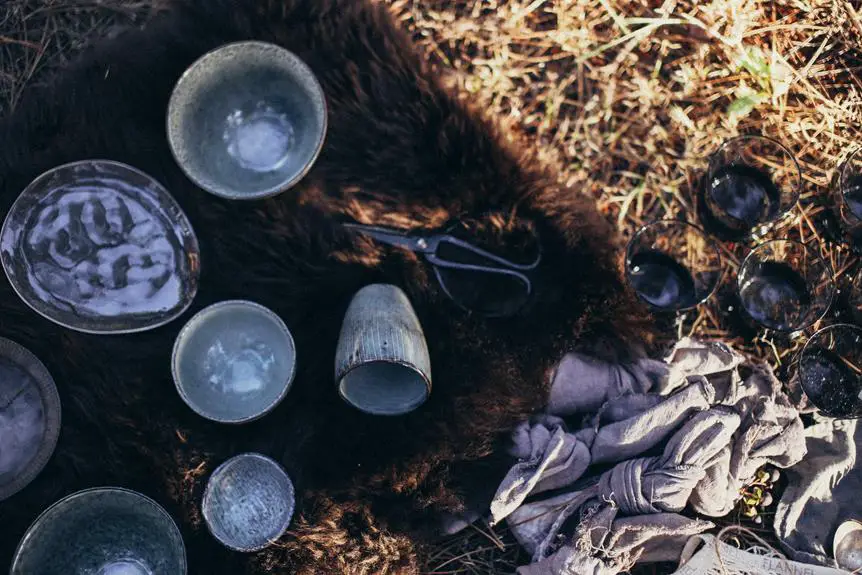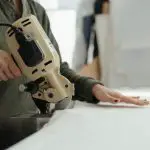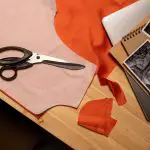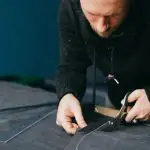Do you ever find yourself reaching for a trusty pair of regular scissors to tackle your fabric projects? It's time to unravel the mystery of fabric scissors versus regular scissors.
Understanding the nuances between these two tools can elevate your cutting game to a whole new level. From blade design to specialized uses, mastering the differences will help you achieve cleaner cuts and preserve the integrity of your fabrics.
So, let's dive in and explore the key distinctions that will empower you to choose the right tool for the job and unleash your creativity with finesse.
Key Takeaways
- Fabric scissors have a different blade angle and sharpness compared to regular scissors.
- Fabric scissors have longer blades and a finer, sharper edge.
- Regular scissors may result in uneven edges and fraying when used to cut fabric.
- Fabric-specific scissors are designed for different fabric types and prevent fraying while achieving clean cuts.
Blade Design
If you're wondering about the difference between fabric scissors and regular scissors, the blade design is a crucial factor to consider. Fabric scissors are specifically designed with a different blade angle and sharpness compared to regular scissors. The cutting angle of fabric scissors allows for better precision and control when cutting through various types of fabric. The blades are often longer and have a finer, sharper edge, which prevents the fabric from fraying or bunching up during the cutting process.
In contrast, regular scissors have a more general-purpose design and may not have the same level of blade sharpness or cutting angle suited for fabric. Using regular scissors to cut fabric can result in uneven edges and may cause the fabric to fray, making it challenging to achieve clean, professional-looking cuts.
Understanding the differences in blade design between fabric scissors and regular scissors is essential for anyone working with fabric. Investing in a good pair of fabric scissors with the appropriate blade sharpness and cutting angle can significantly improve the quality and precision of your fabric cutting projects.
Cutting Technique
When cutting fabric, it's important to use a precise and controlled technique with fabric scissors, allowing for smooth, clean edges and minimal fraying. To master this, consider the following key points:
- Cutting Angles: Ensure that you position the fabric properly and adjust the angle of the scissors to match the shape of the pattern or the straight line you intend to cut. This will help you achieve accurate and neat cuts, especially for intricate designs or curved edges.
- Proper Pressure: Apply just enough pressure to the scissors to smoothly glide through the fabric. Too much force can cause jagged edges, while too little pressure may result in an uneven cut. Practice finding the right balance to achieve clean and professional-looking results.
- Blade Sharpness: Regularly sharpen your fabric scissors to maintain their effectiveness. Dull blades can cause fabric to fray or bunch up, leading to imprecise cuts. A sharp blade ensures a clean and effortless cutting experience.
- Cutting Speed: Find a comfortable and controlled cutting speed. Rushing through the cutting process can lead to mistakes, while overly slow cutting might cause the fabric to shift or bunch. Strive for a consistent pace to achieve precise and smooth cuts.
Material Compatibility
When it comes to material compatibility, fabric scissors are designed with fabric-specific blades that provide precision cutting control, allowing you to effortlessly cut through different types of fabrics. Regular scissors may struggle with certain fabrics due to their generic blade design, which can lead to fraying or uneven cuts.
Understanding the importance of material-specific scissors can significantly improve the quality of your fabric projects and make your cutting experience more efficient and enjoyable.
Fabric-Specific Blades
As you're considering the key differences between fabric shears and regular scissors, it's crucial to understand that fabric-specific blades are designed to ensure optimal compatibility with various types of materials. When it comes to fabric-specific blades, here's what sets them apart:
- Sharper Blades: Fabric scissors have sharper blades compared to regular scissors, allowing for precise and clean cuts through different types of fabric.
- Micro-Serrated Edges: Some fabric-specific blades feature micro-serrated edges, which grip the fabric and prevent slippage, ensuring accurate cutting.
- Reduced Fraying: These blades are designed to minimize fraying by cleanly cutting through fabric fibers, making them ideal for sewing and quilting projects.
- Versatile Cutting: Fabric-specific blades are suitable for cutting through various materials such as silk, denim, cotton, and more, offering versatility for different sewing needs.
Understanding these distinctions can help you choose the right tool for your fabric cutting tasks.
Precision Cutting Control
To achieve precise cutting control for different materials, you need to consider the compatibility of the scissors with the specific fabric you are working with. The design of the scissors greatly influences cutting control, making it essential to choose the right tool for the job. Below is a table highlighting the importance of scissor design and its impact on cutting control for different materials:
| Material | Scissor Design | Cutting Control |
|---|---|---|
| Light Fabrics | Fine, pointed tips | Enhanced precision and maneuverability |
| Heavy Fabrics | Strong, sturdy blades | Improved cutting power and control |
| Delicate Fabrics | Micro-serrated blades | Minimized fraying and clean cuts |
Choosing scissors designed for the specific fabric you are working with can significantly enhance your cutting control and the overall quality of your work.
Ergonomics and Handle Design
When it comes to the difference between fabric scissors and regular scissors, the ergonomic design and comfortable grip are key factors.
Fabric scissors are specifically designed to reduce hand fatigue and provide precise cutting control. Their handle design is tailored to meet the unique demands of cutting fabric, making them a specialized tool for anyone working with textiles.
Comfortable Grip for Precision
Choosing the right scissors with a comfortable grip is essential for achieving precision in your cutting tasks, especially when dealing with fabrics. When it comes to comfortable grips for precision cutting, consider the following:
- Ergonomic Handles: Look for scissors with contoured handles that fit the natural shape of your hand, reducing strain during extended use.
- Soft Grip Materials: Opt for scissors with soft, cushioned grips that provide comfort and reduce hand fatigue, allowing for better control and accuracy.
- Adjustable Tension Screw: Choose scissors with an adjustable tension screw, enabling you to customize the cutting tension to suit your hand strength and cutting style.
- Finger Rests: Seek scissors with finger rests or tangs that offer additional support and stability, promoting a more relaxed and controlled cutting motion.
Ensuring a comfortable grip won't only enhance hand comfort but also improve your cutting precision, making your fabric cutting tasks more efficient and enjoyable.
Reduced Hand Fatigue
Consider how ergonomic handle design reduces hand fatigue when using fabric scissors, allowing for prolonged use without discomfort.
The design of fabric scissors is optimized for hand comfort during long sewing projects. The handles are often larger and have soft, rubberized linings to provide a more secure grip and reduce strain on the hands.
This thoughtful design significantly enhances the overall longevity and ease of use, enabling you to work on your projects for extended periods without experiencing hand fatigue.
By incorporating ergonomic principles, fabric scissors are engineered to minimize the effort required to cut through various fabrics, ultimately contributing to a more enjoyable and efficient sewing experience.
When selecting fabric scissors, prioritize ergonomic handle designs to ensure optimal hand comfort and reduced fatigue throughout your sewing endeavors.
Specialized for Fabric
You'll frequently find that fabric scissors are specifically designed with ergonomic handles, providing a comfortable grip and reducing hand fatigue during prolonged use. This design is tailored to the specific needs of fabric handling and sewing projects, ensuring precision and ease of use.
Here's why specialized fabric scissors excel in ergonomics and handle design:
- Ergonomic Handles: The handles are shaped to fit the natural contours of your hand, reducing strain and discomfort during use.
- Extended Handles: Some fabric scissors have longer handles, allowing for a better grip and improved leverage, which is especially useful when cutting through multiple layers of fabric.
- Soft Grip: Many fabric scissors feature soft, cushioned grips that provide additional comfort, making them ideal for extended cutting sessions.
- Ambidextrous Design: Certain fabric scissors are designed to be comfortable for both right-handed and left-handed users, ensuring inclusivity and ease of use.
Maintenance and Care
To maintain and care for your fabric scissors properly, it's important to regularly clean and oil the blades. Fabric scissors should be cleaned after each use to remove any lint or residue that may have accumulated. Use a soft cloth or a brush to wipe the blades clean, and if necessary, use a mild soap and water solution to remove stubborn stains. After cleaning, make sure to dry the scissors thoroughly to prevent rusting.
In addition to regular cleaning, it's essential to oil the scissors to keep them in optimal condition. Apply a small amount of oil to the pivot area and the blades, then open and close the scissors several times to distribute the oil evenly. This helps to prevent corrosion and ensures smooth cutting action.
When it comes to sharpening frequency, fabric scissors should be sharpened at least once or twice a year, depending on usage. If you notice that the scissors aren't cutting as effectively as before, it's time to sharpen them. Consider having them professionally sharpened for the best results, or use a sharpening stone if you're confident in your sharpening skills.
Proper maintenance and care will extend the life of your fabric scissors and keep them performing at their best.
Specialized Uses
One major benefit of fabric scissors is their ability to make precise and clean cuts through various types of fabrics. When it comes to specialized uses, fabric scissors offer distinct advantages that can elevate your sewing and crafting projects.
Here's how fabric scissors can be particularly beneficial:
- Fabric types: Fabric scissors are designed to cut through a wide range of fabrics, including delicate materials like silk and satin, as well as heavier fabrics such as denim and upholstery fabric.
- Cutting angles: Fabric scissors are adept at cutting different angles, allowing you to create intricate shapes and patterns with ease. Whether you need to make straight cuts, smooth curves, or intricate designs, fabric scissors provide the precision required for these tasks.
- Specialized projects: Fabric scissors are indispensable for specialized sewing and crafting projects such as quilting, dressmaking, and upholstery work. Their ability to handle various fabric weights and textures makes them essential tools for these endeavors.
- Fabric weight: Unlike regular scissors, fabric scissors are optimized to handle varying fabric weights, ensuring that you can achieve clean, accurate cuts without fraying or damaging the material.
Frequently Asked Questions
Can Regular Scissors Be Used to Cut Fabric, or Do I Really Need Fabric Scissors?
You can use regular scissors for fabric, but fabric scissors are better. They're designed for fabric quality and offer more versatility. Regular scissors may struggle with thicker or delicate materials, while fabric scissors ensure better precision and material compatibility.
Are There Any Safety Considerations When Using Fabric Scissors Versus Regular Scissors?
When using fabric scissors, proper technique is crucial for safety. Always keep them sharp and avoid cutting through pins or other metal objects. Use regular scissors for non-fabric materials to prevent damage and ensure safety.
Can I Use Fabric Scissors for Other Materials Besides Fabric?
Yes, you can use fabric scissors for cutting metal jewelry and paper crafting. However, it's important to keep in mind that using fabric scissors for these materials may dull the blades faster than using them solely for fabric.
How Often Should I Sharpen Fabric Scissors Compared to Regular Scissors?
You should sharpen fabric scissors more often than regular scissors because they're used on tougher materials. Proper maintenance is key to keeping them sharp. Fabric scissors' blade durability can be affected by wear and tear from frequent use.
Are There Any Specific Types of Projects Where Regular Scissors Are Better Than Fabric Scissors?
For intricate crafting with regular scissors, like detailed paper cutting, regular scissors are better. However, for precision in fabric projects, fabric scissors are essential. Regular scissors for paper, fabric scissors for fabric—each has its specialized use.
- What Is Acetate Fabric? Everything You Need to Know - June 24, 2025
- Beyond the Gown: 5 Unexpected Uses for Duchess Satin Fabric - June 24, 2025
- Duchess Satin for Structured Silhouettes: A-Line Gowns, Skirts, and More - June 24, 2025






